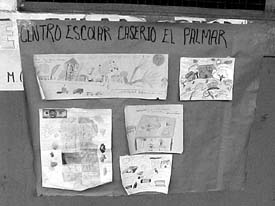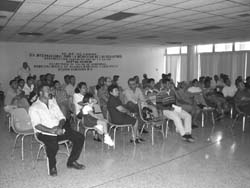|
Latin
America and the Caribbean Celebrating the
International Day for Natural Disaster Reduction
10 October 2001
This year, the theme
of ISDR’s annual World Disaster Reduction Campaign is “Countering
Disasters; Targeting Vulnerability”. The campaign’s objective
is to provide practical examples of the measures that can be taken to
reduce vulnerability to natural hazards such as earthquakes, floods, drought,
or landslides.
The 2001 Campaign
has also focused on three sub-themes:
• The Role of
Science and Technology in Disaster Reduction
• Building Disaster-Resistant Infrastructure
• Mobilizing Local Communities in Reducing Disasters.
The World Disaster Reduction Campaign is a year-long event. It culminates
with the International Day for Natural Disaster Reduction. The United
Nations agreed to set aside the second Wednesday of October of every year
to underscore the importance of disaster reduction around the world. This
year, the day was celebrated on 10 October with the presentation in Geneva
of the United Nations Sasakawa Award for Disaster Reduction to the Global
Fire Monitoring Centre (GFMC), Fire Ecology Research Group, Max Planck
Institute of Freiburg University, Germany, for its outstanding work in
the field of wildfire prevention.
Peru
 In
Trujillo, Peru, the Secretariat of the Hemispheric Action Plan for Vulnerability
Reduction in the Education Sector to Socio-Natural Disasters (EDUPLAN)
organized activities for the North of the country, particularly Huaraz,
La Libertad, Lambayeque, Piura, and Amazonas. A World Meeting of School
Children brought together schoolchildren from all over the world to discuss
disaster reduction and radio communications. In
Trujillo, Peru, the Secretariat of the Hemispheric Action Plan for Vulnerability
Reduction in the Education Sector to Socio-Natural Disasters (EDUPLAN)
organized activities for the North of the country, particularly Huaraz,
La Libertad, Lambayeque, Piura, and Amazonas. A World Meeting of School
Children brought together schoolchildren from all over the world to discuss
disaster reduction and radio communications.
The Ministry of Education
and the National Civil Defence Institute (INDECI) organized four school
emergency drills between 31 May and 11 October. In the Arequipa region,
a massive training campaign was aimed at raising awareness of practical
measures to reduce the impact of disasters.
On 10 October, an
earthquake simulation was carried out based on an event of 7 on the Richter
Scale with its epicentre 20 km off the coast in the district of Ancón.
The the population of Lima and nearby Callao participated in the exercise.
Brazil
 In
order to celebrate the World Day for Disaster Reduction, the Civil Defense
Unit of Rio Claro, Sao Paulo, organized a number of training sessions
related to the topics of the World Campaign for Disaster Reduction. In
order to celebrate the World Day for Disaster Reduction, the Civil Defense
Unit of Rio Claro, Sao Paulo, organized a number of training sessions
related to the topics of the World Campaign for Disaster Reduction.
Uruguay
 On
10 October, the Ministry of Education’s Emergency and Disaster Commission
organized a seminar and workshop in the Department (Province) of Durazno
with the support of the United States Agency for International Development’s
Office for Foreign Disaster Assistance (USAID/OFDA), the National Emergency
System, and the local government. School children, community leaders and
the media all took part in the event. On
10 October, the Ministry of Education’s Emergency and Disaster Commission
organized a seminar and workshop in the Department (Province) of Durazno
with the support of the United States Agency for International Development’s
Office for Foreign Disaster Assistance (USAID/OFDA), the National Emergency
System, and the local government. School children, community leaders and
the media all took part in the event.
Argentina
To celebrate International Disaster Reduction Day, the Argentinean School
of Relief and Rescue Techniques organized a drill at the Schweitzer School
in Mar del Plata. Its interdisciplinary academic staff organized the event.
Cuba
The Faculty of Construction of the University of Camagüey organized
a National Workshop on Defense Preparedness Disciplines to share experiences
in this field and to commemorate the International Day for Natural Disaster
Reduction.
El Salvador
 Two
activities were held in El Salvador on 10 October: a local one, in Cara
Sucia, Ahuacha-pán, and a national-level event in San Salvador.
The local activity consisted of awarding prices in a painting contest
for all schools in the municipality, and a talk by the municipal disaster
manager on the importance of preserving natural resources to prevent and
mitigate disasters. Members of the community sang songs they had written
themselves on disaster prevention and acted in a play on how floods destroy
lives and property. In San Salvador, the Ministry of Health organized
an event on Risk Management for all health personnel. Two
activities were held in El Salvador on 10 October: a local one, in Cara
Sucia, Ahuacha-pán, and a national-level event in San Salvador.
The local activity consisted of awarding prices in a painting contest
for all schools in the municipality, and a talk by the municipal disaster
manager on the importance of preserving natural resources to prevent and
mitigate disasters. Members of the community sang songs they had written
themselves on disaster prevention and acted in a play on how floods destroy
lives and property. In San Salvador, the Ministry of Health organized
an event on Risk Management for all health personnel.
Costa Rica
 Costa
Rica’s National Risk Prevention and Emergency Response Commission
(CNE), the country’s focal point for disaster reduction, celebrated
the International Day for Natural Disaster Reduction by organizing a Basic
Community Exercise in Disaster Preparedness. It involved an evacuation
drill based on the likelihood of the Reventado River flooding and causing
a mudslide affecting the communities of Tierra Blanca, Linda Vista, María
Auxiliadora, and Barrio Nuevo, near the old Costa Rican capital of Cartago,
and a fire drill in neighbouring Barrio Miraflores and Dique Río
Reventado. The successful exercise, which lasted 70 minutes, enjoyed the
support of the United Nations System, local emergency committees, first
response agencies, evaluators, monitors, direct and indirect observers
and the mass media. Costa
Rica’s National Risk Prevention and Emergency Response Commission
(CNE), the country’s focal point for disaster reduction, celebrated
the International Day for Natural Disaster Reduction by organizing a Basic
Community Exercise in Disaster Preparedness. It involved an evacuation
drill based on the likelihood of the Reventado River flooding and causing
a mudslide affecting the communities of Tierra Blanca, Linda Vista, María
Auxiliadora, and Barrio Nuevo, near the old Costa Rican capital of Cartago,
and a fire drill in neighbouring Barrio Miraflores and Dique Río
Reventado. The successful exercise, which lasted 70 minutes, enjoyed the
support of the United Nations System, local emergency committees, first
response agencies, evaluators, monitors, direct and indirect observers
and the mass media.
In addition, a poster
was designed to reinforce a campaign to reduce the impact of earthquakes,
which CNE launched on that same day.
Furthermore, the Inter-Institutional
Emergency Commission, of the University of Costa Rica (UCR), organized
a forum titled: “The Role of the Media in disseminating Information
on Disaster and Responding to Emergencies”. Representatives from
the National Emergency Commission and the Municipality of San Jose, as
well as the Director of the UCR’s School of Communications, a participant
from the National Meteorological Institute and a newscaster from a local
TV channel were brought together on this occasion.
Honduras
 The
World Day for Disaster Reduction, the Health Secretariat of Honduras,
and the Municipalities of Alianza, Marcovia and Choluteca, organized an
activity that represented a valuable opportunity for Local Committees
for Health Emergency (COLES) to present on their current work, their risk
maps and issues learned during a first aid course taught by the Health
Secretariat. The
World Day for Disaster Reduction, the Health Secretariat of Honduras,
and the Municipalities of Alianza, Marcovia and Choluteca, organized an
activity that represented a valuable opportunity for Local Committees
for Health Emergency (COLES) to present on their current work, their risk
maps and issues learned during a first aid course taught by the Health
Secretariat.
Representatives from
the communities of Sedeño, Monjarás, Los Llanitos, El Cubulero
and El Conchal participated in this activity, as well as staff members
from the Health and Education Departments, COPECO, the Red Cross, the
Green cross, firefighters, mayor candidates and the media.
Nicaragua
 On
17 August, the municipality of Moyogalpa on Ometepe island, one of the
must vulnerable in Nicaragua, celebrated for the first time Municipal
Disaster Prevention Day. Since November 2000, the entire population of
Moyogalpa has been involved in training, organization and awareness-raising
for disaster prevention, thanks to a joint program by the Pan-American
Health Organization and World Health Organization (PAHO/WHO), the Ministry
of Health, the Ministry of Education, local authorities and community
leaders, among others. On
17 August, the municipality of Moyogalpa on Ometepe island, one of the
must vulnerable in Nicaragua, celebrated for the first time Municipal
Disaster Prevention Day. Since November 2000, the entire population of
Moyogalpa has been involved in training, organization and awareness-raising
for disaster prevention, thanks to a joint program by the Pan-American
Health Organization and World Health Organization (PAHO/WHO), the Ministry
of Health, the Ministry of Education, local authorities and community
leaders, among others.
Moyogalpa’s inhabitants
showed off their knowledge of disaster reduction by producing 15 parade
floats on the subject. A jury selected the three floats that best conveyed
the message of disaster prevention by handing out awards ranging from
US$700 to US$300. The award money was spent entirely on projects to reduce
the vulnerability of the community.
Colombia
An event aimed at raising awareness about disasters was carried out in
the Municipality of Florida, Cauca Valley. Issues addressed and the number
of participants are as follow:
Disasters and the
educational system (70 high school students); what are disasters?
(70 high school students); communities coping with disasters (50 community
representatives); earthquake resistant buildings (40 construction workers);
organization in case of disasters (50 EMS workers), emergency drills (representatives
from relief institutions), and closing and acknowledgements.
At the same time,
institutional material related to these issues was displayed, allowing
the community to be aware of a number of bodies that deal with disaster
prevention and management from different perspectives and approaches.
Furthermore, the two
local TV stations of this municipality, showed movies related to disasters,
such as “A thousand heroes at rescue”, “Volcano” and
“Fireball”, while radio stations broadcast a series of programs
during the entire day of this event.
|




